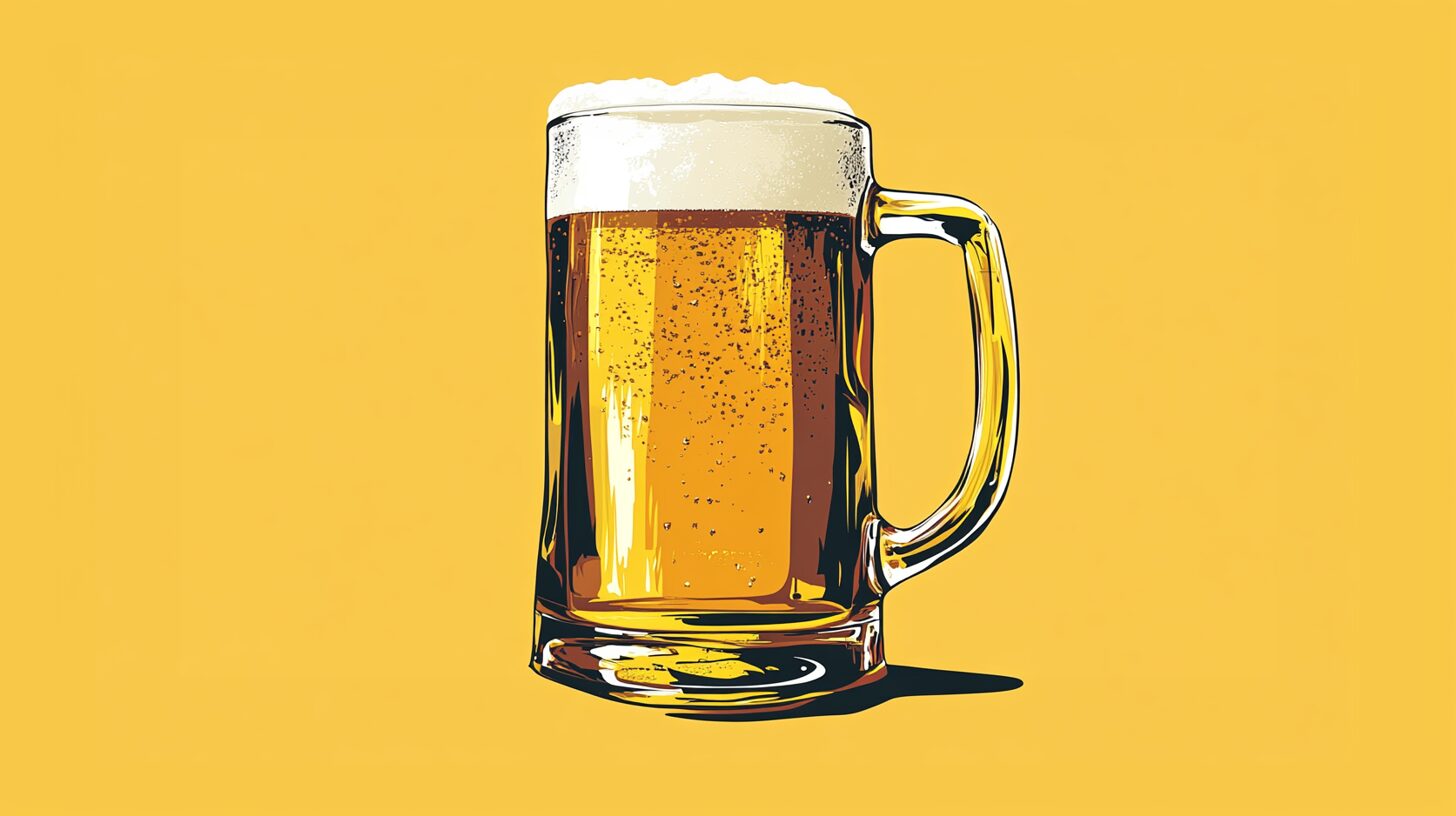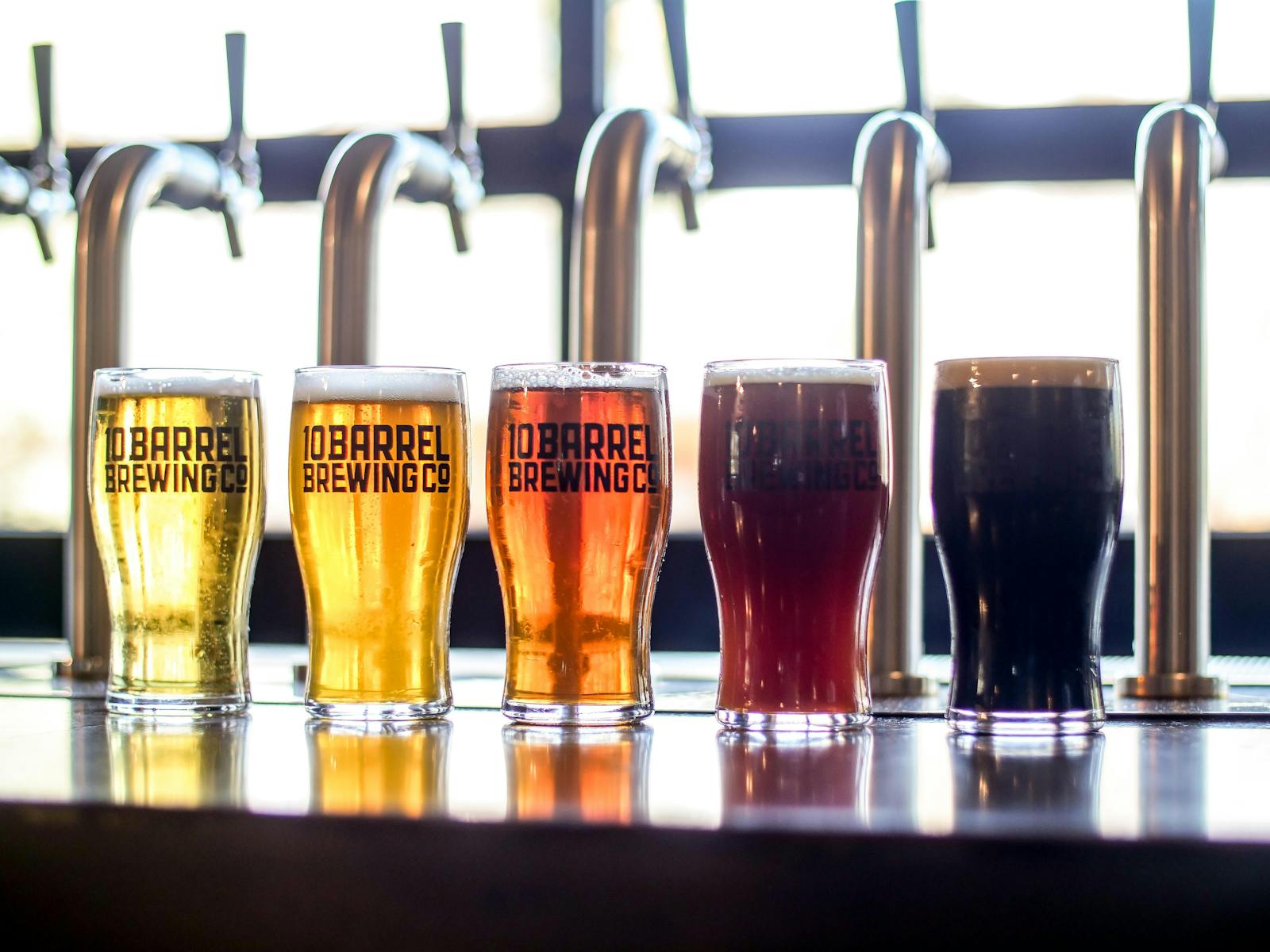The Origin of Beer
Beer’s got quite the story, going way back into the dusty pages of ancient history. Let’s take a peek at how some of the earliest civilizations in Mesopotamia got this whole brewing party started and the nifty tricks they used to make this frothy delight.
Mesopotamian Brewing Beginnings
We’re zooming back in time here to ancient Mesopotamia, which is now where modern Iraq sprawls under the sun. About 5,000 BCE, the Sumerians were the OG brewers, crafting beer using barley. Probably one of those happy accidents of nature, this brewing kick-off might have happened when some grains went on a little fermentation spree.
There’s this wicked old recipe dated around 3,900 years ago that gives a nod to Ninkasi, the brewing goddess. This ancient recipe-alchemy speaks volumes of the Sumerians’ knack for turning barley bread into a tasty brew, painting a vivid picture of their society’s love affair with beer.
Early Beer Production Techniques
So, what was the brewing scene like back in the day? Well, it started with a bit of kitchen sorcery involving barley, wheat, and maize. Thanks to their green-thumb prowess, the Sumerians experimented with these ingredients like culinary wizards.
| Ingredient | Reason to Use |
|---|---|
| Barley | Life of the party, main fermenter |
| Wheat | Twirls in some pizzazz with flavor and texture |
| Maize | The backup dancer in the brewing lineup |
The recipe was as simple as it gets. Grains got a nice soak to start sprouting, converting starches into sugar magic. Toss in some water and other stuff, let it chill out in the corner at room temp, and boom! What you have is a drink that wasn’t just about quenching thirst—it was like a VIP guest at Sumerian feasts and sacred gigs.
Sumerians, being the champs they were, tweaked their brewing antics to get diverse flavors and types. Beer became a staple at meals and spiritual shindigs, making it an integral part of their lifestyle. It’s this bond with ancient culture that keeps my craft beer obsession ticking. If you’re curious about different styles, our types of beer guide has got your back.
This Mesopotamian brewing saga paved the way for all sorts of fun with craft beers today. Digging into this rich history enlarges my appreciation for what’s in my mug as I dive headfirst into the world of craft beer tastings and tales.
Historical Evolution of Beer
Boy, oh boy, the tale of beer is as old as time—and just as interesting. So let’s take a stroll down memory lane to meet the ancient folks who first raised a mug: Ancient China, the Sumerians, and the Egyptians. Spoiler alert: they liked beer a whole lot.
Beer in Ancient China
So, archaeologists digging around in China found that as far back as 7000 BCE, folks were already getting crafty with grains, rice, honey, and some fruit action to brew up a storm. This wasn’t just a random hobby—beer was like the life of the party, whether at home or during big community shindigs. Think of it as the ancient version of bringing a six-pack to a cookout.
The Sumerian Brewing Tradition
Next up, let’s chat about our Sumerian pals over in Mesopotamia. These guys are credited with concocting the first barley brew around 5,000 years ago. The evidence? Clever detectives found beery residue on ceramic vessels from back in 3400 B.C. (History). And get this, they even penned a hymn to Ninkasi, goddess of brewing—now that’s dedication! This ancient number contains the oldest known beer recipe, and they brewed using barley bread. They were basically geniuses with a love for a good time (Wikipedia).
Beer in Ancient Egypt
Zooming over to Ancient Egypt, beer wasn’t just a drink; it was essential, like how we see coffee today. Everyone, even pharaohs, enjoyed it, and it had religious and ritualistic vibes. Off to work? Beer was basically part of the paycheck, fueling pyramid builders one sip at a time. They even found a brewery dating back 5,000 years (Precision Fermentation). Beer wasn’t just a drink—it was a way of life, an integral part of the culture.
As I plunge into the bubbling kettle that is the history of beer, it’s amazing how each ancient culture took this humble drink and turned it into something that rocked their world. They laid the groundwork for today’s beer-loving society and the craftiness of today’s breweries. Cheers to history! 🍻
Beer Through the Ages
Taking a stroll through the history of beer is like opening a time capsule of bubbling hops and malty goodness. From medieval taverns to today’s cutting-edge breweries, it’s wild to see how beer’s evolved while still keeping one foot rooted in its past. Let’s raise a glass to history.
Beer in the Middle Ages
Back when knights were busy gallivanting around, brewing beer was a regular gig for women, more akin to baking bread than popping into a brewery. It wasn’t just a household task; it was a craft, a legacy. The unsung heroes of brewing were actually the monks. These quiet guys not only rocked the habit but also raised the bar on beer-making. They played around with ingredients like it was Sunday brunch, whipping up varied beer styles. Imagine the monastery with its own experimental micro-brewery long before it became trendy (Bath Rd Beers).
| Brewing Aspect | Description |
|---|---|
| Who’s Brewing? | Women at the helm in homes |
| Monastic Magic | Pioneers of quality and ingredient experiments |
| Beer Buffet | Unique regional brews popped up |
Industrial Revolution and Beer
Then came the Industrial Revolution, which catapulted beer production into the big leagues. The steam engine, born in 1765, was to beer what the electric guitar was to rock ‘n’ roll—a total game changer. Suddenly, brewing took on a whole new level of efficiency. Our good friends the thermometer and hydrometer made their entrance a bit later, making sure those fermenting suds stayed just right (Wikipedia). With these innovations, beer moved from local watering holes to the masses, becoming everyone’s buddy.
| Improvement | Effect on Brewing |
|---|---|
| Steam Engine | Made brewing faster and larger-scale |
| Thermometer | Fine-tuned temp control |
| Hydrometer | Kept an eye on fermentation perfection |
Modern Beer Brewing Innovations
Zoom to today, and you’re in the middle of a craft beer renaissance. With over 9,000 breweries stateside, these small-batch pioneers have painted the beer scene with artisanal flair, making everyone rethink their brew. Today’s mavericks are hitting it out of the park with funky flavors and ground-breaking styles. Big brands are trying to keep up—or catch up (Precision Fermentation). The magic of modern science, like pasteurization and refrigeration, keeps beer tasting fresh and clean, ready for its red carpet debut to the masses.
| Modern Innovation | Description |
|---|---|
| Artisanal Awesomeness | Unique flavors that stand out |
| Pasteurization | Keeps your brew safe and sound longer |
| Refrigeration | Keeps your brew chill and crisp |
Whether you’re stirring up your own hoppy potions at home or chasing the next big craft beer release at your local joint, knowing where beer’s been adds a whole new appreciation for what’s in your glass. For more info to tickle your taste buds, check out our guide to craft beer or see what varieties are out there in our types of beer chat.
The Influence of Beer on Society
Beer isn’t just what you grab after a long day; it’s had its fingers in society’s pie for ages. From its days as old-school cash to rocking early village vibes and putting women front and center of the brewing scene, beer’s journey is tied to our own story.
Beer as Currency
Back when pyramids were the hot new thing, and people thought the wheel was cutting-edge tech, the Sumerians were ahead of their time using beer as money. Yup, in Uruk, you could swap a mug of brew for shiny rocks or slabs of wood. Imagine bartering for a shiny necklace or a fancy shield with a jug of beer! (Source: Armstrong Undergraduate Journal of History)
| Beer Features | How It Worked like Money |
|---|---|
| Tasty Value | Swap it for stuff |
| Easy to Count | Measured in pints or barrels |
| Trade Tool | Widely accepted for trading |
Role of Beer in Early Settlements
Who’d have thunk beer would influence folks to quit wandering and set up camp? The craving for a cold one nudged folks towards farming—sparking the “settling down” trend way back when. Imagine weddings and communal shindigs fueled by beer, bringing people together like a neighborhood block party back in the day (Source: Armstrong Undergraduate Journal of History).
Women in Beer Brewing
In Mesopotamia, back when men were busy chest-thumping or whatever, it was the ladies who ran the beer game. Brewing was their jam, giving them a slice of the economic pie and a voice in town. Imagine them juggling taverns and bakeries like bosses, proving you should never underestimate the power of a woman with a brew kettle (Source: Armstrong Undergraduate Journal of History).
Peeling back the layers of history, it’s like sipping a rich stout—you gain appreciation for beer’s role in our collective story. For a modern twist, check out our guide to craft beer to deepen your beer knowledge. Cheers to history in a mug!
Nutritional and Social Aspects of Beer
Beer isn’t just a frosty mug at the end of a long day; it’s been a game-changer for society and nutrition through the ages. I can’t help but get caught up in how ancient folks saw beer—not just as a belly-filler, but as a key player in social circles.
Nutritional Benefits of Sumerian Beer
Back in the old days in Mesopotamia, Sumerian beer was more than a boozy drink—it was a staple, almost like bread. They whipped it up using barley, and threw in bits like fenugreek, dates, and coriander. Think of it as the original superfood smoothie, but with a low-gear alcohol buzz. It went down easy and got more nutrition outta their grub.
| Nutritional Aspects | Description |
|---|---|
| Key Ingredients | Barley, fenugreek, dates, coriander |
| Alcohol Content | Low |
| Dietary Benefits | Boosts nutrient intake |
Beer wasn’t just for getting the good times rolling, it packed in nutrients and calories that kept the Sumerians fueled. It was a big deal in their communities, helping people settle down as they moved from wandering to planting roots (Armstrong Undergraduate Journal of History).
Social Importance of Beer Consumption
This golden brew was more than a drink—it was a glue for social connections. In Sumer, it was poured during get-togethers, or even swapped around like ancient currency, showing just how crucial it was—and even used to snag gems and wood over in the city of Uruk (Armstrong Undergraduate Journal of History).
Cranking out and knocking back beer wasn’t just a pastime; it turned into a reason to set up shop and come together. It became part of life’s big moments, from weddings to festivals, laying the foundation for tight-knit communities. Beer’s cultural beat still echoes today, linking folks through shared sips across ages.
If you’re diving into beer’s backstory, you’ll find a rich tapestry as flavorful as today’s craft brew scene. Curious about the types of beer or itching to dive into the craft beer scene? The seeds of this legendary libation have indeed sown connections woven through time, fueling our social circles for ages.
Beer Innovations and Advancements
When I dip my toes into the history of beer, I can’t help but notice how a few major shake-ups have changed our favorite bubbly brew forever. From hops entering the picture to factories cranking up production, each moment in time has stamped its mark on what we gulp down today.
Introduction of Hops
Picture it: Europe in the 11th century, and bam! Suddenly hops were getting tossed into the mix. This was a total game-changer. Hops brought a whole new flavor, packing a bitter punch that balanced out the sweetness of the malt. I love knowing they also acted like a natural bouncer, keeping the beer fresh and tasty for longer trips. Thanks to hops, the beer scene grew from local hangouts to cross-country road trips. Talk about a glow-up for commercial brewing (Bath Rd Beers).
With hops, the flavor universe opened wide. Suddenly, we had everything from pale ales to lagers showing up at our doors. Hops were the secret sauce transforming beers into complex concoctions even back in the Middle Ages.
Monasteries and Beer Brewing
Ah, the Middle Ages, where monks were the unsung heroes of brewing. Monasteries served as beer’s sanctuary, and monks were the OG craft brewers. They mixed and matched, tested, and perfected their suds, establishing brewing as an art form (Bath Rd Beers).
This dedication paid off as monastic brews often highlighted local flavors. I can’t help but tip my hat to these ancient brewmasters. Their creativity and persistence are the granddaddies of today’s craft beer movement, making them real legends in the beer world.
Industrialization of Beer Production
When the Industrial Revolution hit, it was like beer on steroids. The steam engine burst onto the scene, brewing got serious, and factories started pumping out pints in the late 1700s. Techies of the time saw thermometers and hydrometers as their new toys, which let them nail brewing processes, boost beer quality, and crank up production (Wikipedia).
This was the golden age of beer mass production, making it cheaper and available to all thirsty souls. New tricks like refrigeration and pasteurization took the scene, and beer was suddenly Mr. Consistent. I find it pretty wild to trace my local craft brew’s roots back to these tech leaps, showing how the past flavors what fills our glasses today.
These innovations—adding hops, monastic craftsmanship, and the industrial leap—pretty much created the rich tapestry of beer style we enjoy now. If you’re curious about different brews or thinking of diving into brewing your own, have a peek at our guide to craft beer.
The Craft Beer Movement
Craft beer has flipped the script on how we think about brewing, turning it into a lively party of flavor, originality, and pint-sized production. It’s an open invitation to experiment, letting us beer geeks swim through a sea of flavors that granddad’s beer never dreamed of.
Small-Batch Brewing Revival
Kicking off in the good ol’ USA circa 1980 with trailblazers like Sierra Nevada, the small-batch revival kickstarted a liquid revolution. Now, over 9,000 breweries are churning out unique batches across the country. These brewers aren’t sweating the big production numbers. They’re all about crafting those rare, one-of-a-kind tastes. Each batch is like a creative love letter from the brewer to your taste buds.
| Year | Breweries Making Waves |
|---|---|
| 1980 | Sierra Nevada Brewery |
| 1990 | Dogfish Head Craft Brewery |
| 2000 | Stone Brewing Co. |
| 2020 | New Belgium Brewing |
Emphasis on Quality and Innovation
Craft brewers play the flavor game like no one else. They use top-notch stuff and are always tinkering with their brewing game plan to let the good times (and beers) roll. From zingy IPAs to dark, moody ales, there’s something for everyone. This wild creativity pushes even the old-school beer giants to keep up! If you’re looking to dip your toes into the beer world, check out our guide on types of beer.
Community Impact of Craft Beer
Craft beer doesn’t just fill glasses—it fills hearts and connects folks. Local breweries are the modern-day meeting spots where beer buffs come to sip and share tales. Beer events, festivals, and tastings are common—whether you’re in a tiny town or a big city, these gatherings are where friendships are forged over frothy mugs. Plus, with craft beer subscriptions like best beer subscription services, new and thrilling brews show up at your door, pulling you tighter into this beery brotherhood.
As I sip my way through the fascinating world of craft beer, I’m thrilled to see how this movement keeps shaking up how we appreciate a good brew. Unraveling the craftsmanship of these beers offers a dive into a world where every sip tells a story, making every glass taste like an adventure.
Global Beer Consumption and Trends
Diving into the tale of beer’s journey over the years has been an eye-opener, seeing how it’s managed to stay a top favorite around the globe today. I mean, people downed over 166 billion liters in 2023, with predictions it will hit 170 billion in 2024, maybe even 180 billion by 2027. That’s a whole lotta hops!
Consumption Patterns Over Time
Beer drinking trends kinda mirror what’s been happening in societies. Imagine following these numbers like a soda straw marking the journey:
| Year | Consumption (Billion Liters) |
|---|---|
| 2021 | 164 |
| 2022 | 165 |
| 2023 | 166 |
| 2024 (Projected) | 170 |
| 2027 (Projected) | 180 |
This climb on the charts shows beer will likely keep its crown as king of drinks worldwide.
Popular Beer Brands Worldwide
Some beer brands have danced their way into our hearts and mugs. Heineken, hailing from the Netherlands, tops the charts, winning fans from Brazil to Greece. Then there’s Modelo from Mexico, which flexed its export muscles with a whopping $5.4 billion worth of beer shipped out in 2022. These brands rock the global beer stage!
| Brand | Origin | Notable Markets |
|---|---|---|
| Heineken | Netherlands | Brazil, Australia, Greece |
| Modelo | Mexico | Chile, Argentina, Angola |
Economic Impact of the Beer Industry
Beer isn’t just for fun; it’s a heavyweight in the world’s economy, packing a punch of $555 billion to the global GDP! That number covers everything from making it to the impact on fields and restaurants. Here in the US, the craft beer wave is crashing hard with over 9,000 breweries showing up on our radars. This trend has old giants rethinking their game to cater to folks who dig craft and unique brews.
For anyone wanting to sip on some life lessons in flavor, my guide to craft beer has your back with all the juicy deets. New to the scene or a seasoned taster, following these trends can make your beer adventures a lot more flavorful. Cheers to that!
Affiliate Disclosure: This post may contain affiliate links. If you click and purchase through one of these links, we may receive a small commission at no extra cost to you. Thank you for your support!




